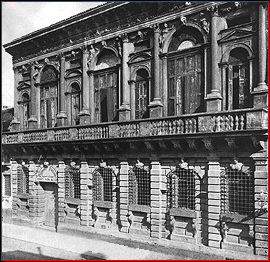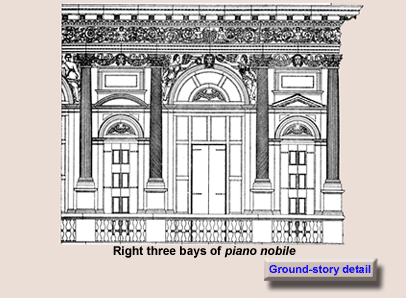Palazzo Bevilacqua
Verona, c. 1530
Architect: Sanmicheli
BACKGROUND
Commission
Michele Sanmicheli was commissioned to add a new façade and grand salone to a large medieval palace in Verona for two brothers, Antonio and Gregorio Bevilacqua.
Asymmetrical Location of Entrance
The entrance is located in the second bay from the left of the palace's seven-bay façade. The off-center placement of the door reflects the layout of the existing Medieval palace, and probably, an intention of adding four bays if the property on the left became available.
ORNAMENTATION
Inclination toward Rich Effects
The Palazzo Bevilacqua is the most Mannerist of Sanmicheli's designs. It demonstrates his inclination toward complexity and textural richness.
Ground Story
The vigorously textured rustication of the ground story is enlivened by a multiplicity of features and wall planes consisting of columns, arches, walls, and window frames.
Piano Nobile
The piano nobile is decorated by a profusion of relief sculpture, which decorates the upper walls between the capitals and fills the frieze, the spandrels, and the lunettes. The architectural order selected is the most ornate of the orders, the Corinthian order.
A variety of vertically arranged moldings add to the complication of the ornamental scheme.
INFLUENTIAL ROMAN PALACES
Contemporary Roman Palaces
Because Sanmicheli spent nearly three decades in and near Rome, he was familiar with the latest architectural trends and palaces.
Little Similarity to Palazzo Caprini
Sanmicheli's Palazzo Bevilacqua has little in common with Bramante's Palazzo Caprini in Rome except the general use of rustication on the ground story and the inclusion of the orders on the piano nobile.
Similarities to Palazzo Branconio dell' Aquila
The Palazzo Bevilacqua is similar to Raphael's Palazzo Branconio dell' Aquila in its general complexity, copious use of relief ornament, and use of the orders on the ground story.
IRREGULAR FEATURES
Mannerist Variations
Sanmicheli created a highly complex rhythm by combining a number of distinct features in unusual ways, a hallmark of mannerism.
Alternation of Wide and Narrow Bays
The use of wide and narrow bays articulated by columns is a variation of Bramante's travata ritmica motif, which was first used on the upper level of the Belvedere Court.
Multiple Types of Fluting
The columns of the piano nobile are fluted in three different ways: vertically, spirally to the left, and spirally to the right.
Except for the use of a single vertically fluted column at each end, the spirally fluted columns are rotated with the vertically fluted columns in sequences of twos: two spirals, then two verticals, and finally two more spirals.
The direction of each spiral column is reversed from the last one so that any two adjacent spiral columns mirror each other.
III \\\ /// III III \\\ /// III
Triangular and Segmental Pediments
The pediments over the arches of the small bays of the upper story are of two different shapes: triangular and segmental.
This combination had been used in a simple alternation by Raphael at the Palazzo Branconio dell'Aquila in Rome and the Palazzo Pandolfini in Florence. At the Palazzo Bevilacqua, Sanmicheli arranged the pediments as inner and outer pairs on alternate bays.
See visual summary by clicking the Views button below.



 Add Placemark
Add Placemark Go Back
Go Back 






